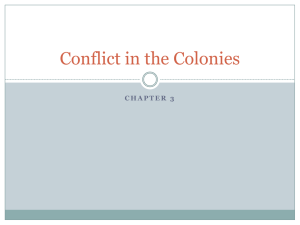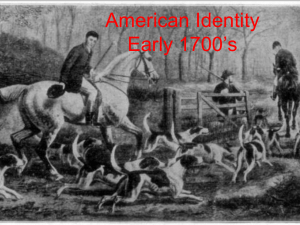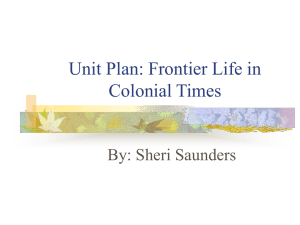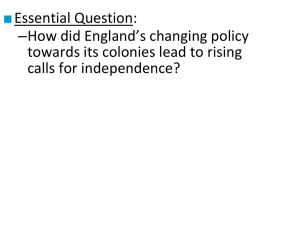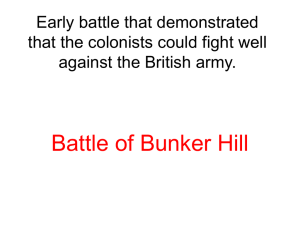KAP notes Chapter 6
advertisement
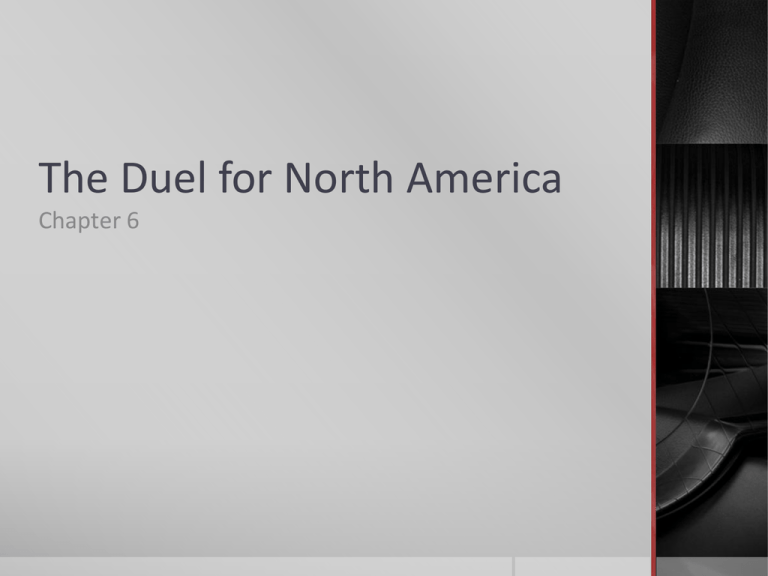
The Duel for North America Chapter 6 France Finds a Foothold in Canada Like England and Holland, France was a latecomer in the scramble for New World real estate. The edict of Nantes in 1598 granted limited toleration to French Protestants. Religious wars ceased and France became the mightiest and most feared nation on the European continent. France Finds a Foothold in Canada France was led by King Louis XIV who was enthroned at the age of 5. King Louis took an interest in overseas exploration. Samuel de Champlain “Father of New France” led the settlement in the New World in Quebec. France Finds a Foothold in Canada Champlain entered into a friendship with the Huron Indians and fought alongside them against the Iroquois. Two volleys from the French “lightning sticks” scared off the Iroquois. From that day, the Iroquois hampered French penetration of the Ohio River Valley. France Finds a Foothold in Canada The government of New France (Canada) was almost completely autocratic. The people elected no representative assemblies. There was also no trial by jury as enjoyed in the English colonies. The Clash of Empires The earliest contests among the Europeans for control of North America, known to the British colonists as King William’s War (1689-1697) and Queen Anne’s War (1702-1713) pitted the British colonists against the French coureurs de bois (“runners of the woods”) and whatever Indian allies they could find. The Clash of Empires Because neither side considered North America worthy of a large detachment of troops of regular troops, so the combatants waged guerilla warfare. After many defeats along the frontier, the British scored a decisive victory at Port Royal in present day Nova Scotia. The peace terms, signed at Utrecht in 1713, the British were awarded Acadia (Nova Scotia), Newfoundland, and Hudson Bay. George Washington Inaugurates War with France The Ohio River Valley becomes a major bone of contention between the French and the British. It was the key for the westward expansion of the British colonists. It was also the key to the link between Canada and the lower Mississippi Valley of France. George Washington Inaugurates War with France In 1749 a group of British colonial speculators (mostly Virginians) secured the right to 50,000 acres in the Ohio River Valley region. The French were in the process of building a chain of forts along the Ohio River (Fort Duquesne along the Monongahela and Allegheny Rivers in present day Pittsburgh). George Washington Inaugurates War with France In 1754, the Governor of VA sent 21 year old surveyor George Washington to secure the land claims of the Virginians. Washington was the lieutenant in charge of 150 VA militiamen who quickly killed the leader of the French troops near Fort Duquesne. Washington’s triumph would not last as his troops were surrounded in Fort Necessity by French reinforcements who, after a ten hour siege, forced Washington to surrender on July 4th, 1754 George Washington Inaugurates War with France Washington was allowed to march his men away with full honors. Fearing an uprising in Nova Scotia, the British uprooted 4,000 French Acadians in 1755. These deportees were sent as far south as Louisiana, where their descendants are now called “Cajuns” and number nearly 1 million. Global War and Colonial Disunity The French and Indian War was the first AngloFrench colonial war to start in America. Also known as the Seven Year’s War, it was fought not only in America, but in Europe , the West Indies, the Philippines, in Africa, and on the ocean. The Seven Year’s War was a seven-seas war. Global War and Colonial Disunity One problem that had effected the colonists during previous wars was their overall inability to become a unified force. This changed when delegates of 7 of the 13 colonies met in Albany, NY and gave 30 wagonloads of gifts, including guns, to the Iroquois Indians in exchange for their help against the hated French. Global War and Colonial Disunity The longer range goal was to achieve colonial unity and bolster the common defense against the French. The most important man at the Albany Congress was Benjamin Franklin who adopted a premature plan for colonial self-rule. The Albany delegates adopted it the plan, but it was spurned by the individual colonies and also in London. Global War and Colonial Disunity The colonists felt that the plan of self-rule did not give them enough independence, whereas the British officials thought it gave too much independence. The disappointing result confirmed one thing for Franklin; all people agreed on the need for union, but their “weak noodles” were “perfectly distracted” when they attempted to agree on details. Braddock’s Blundering and Its Aftermath The opening clashes of the French and Indian War went badly for the British colonists. Gen. Edward Braddock took at detachment of 2,000 British regulars to capture Fort Duquesne. Part of his force were colonial militiamen (known as “buckskins”) who fought from behind trees, much to the contempt of Gen. “Bulldog” Braddock. Braddock’s Blundering and Its Aftermath Braddock’s troops moved slowly to cut a path through the dense wilderness toward Duquesne. The British encountered a much smaller French and Indian unit who quickly retreated into the wilderness and reigned murderous fire upon the British. George Washington, an aide to Braddock, had 2 horses shot from under him, and had four bullets pierce his coat. Braddock was mortally wounded as the British were routed. Braddock’s Blundering and Its Aftermath The Indians went on a bloody warpath, scalping people throughout the countryside. Local authorities offered bounties on Indian scalps $80 for women, $130 for warriors The British tried to attack several Canadian outposts simultaneously instead of focusing their efforts on Quebec and Montreal. Defeat after defeat in America and Europe heavily affected the British colonists. Pitt’s Palm of Victory In the hour of crisis, Britain brought in William Pitt, who was popularly known as the “Great Commoner” who was revered by the common people. Pitt dismissed his old, cautious generals in favor of young, energetic leaders. Pitt picked up a victory in the siege of Louisbourg and then moved on to the Quebec-Montreal area. Pitt’s Palm of Victory The Battle of Quebec in 1759 was one of the most significant engagements in British and American history. When the Montreal fell in 1760, the French flag flew in Canada for the last time. After the Treaty of Paris in 1763, French power was thrown completely off the continent of North America. It did leave behind a French population that is a strong minority in Canada to this day. Pitt’s Palms of Victory Great Britain thus emerged as the dominant power in North America, while taking its place as the leading naval power of the world. Restless Colonists The colonists had fought bravely alongside the well trained British regulars. More importantly, the militiamen had seen that the British, supposedly the best army in the world, was anything but invincible. Contempt grew during the war between the arrogant British and colonials. The British refused to recognize any American militia rank above captain, much to the dismay of “Colonel” George Washington. Restless Colonists The Colonists felt they deserved to be praised by the British for taking a chance, instead of being mocked as “scum” who fled to the “outhouses of civilizations”. The British were further upset that the American shippers were illegally shipping to the West Indies and Spain. Restless Colonists The curse of colonial disunity continued throughout the hostilities for many reasons; Geographical barriers like rivers Conflicting religions (Catholic and Quaker) Varied nationalities (German to Irish) Differing types of colonial governments Boundary disputes Backcountry settlers vs. aristocratic bigwigs Restless Colonists The French and Indian War did, in some ways, help bring the colonists closer together. Eventually they discovered that they were all fellow Americans who generally spoke the same language and shared common ideals. Barriers of disunity began to melt, although a long and rugged road lay ahead before a coherent nation would emerge. War’s Fateful Aftermath Because the colonists had needed security from the mother country, they had to lean on England during the French and Indian War. Now that the French were no longer a threat, the colonists looked forward to moving away from the reach of the British government. The French, although saddened by their loss of America, tried to console themselves in the thought that maybe one day the hated English would also lose America. War’s Fateful Aftermath Pontiac’s Uprising of 1763 tore a violent campaign through parts of present day Ohio and Detroit, Michigan with the aide of other tribes and a few French traders who had remained in the area after the war. The goal was to drive the British settlers out of the area west of the Appalachians. Around 2,000 soldiers and settlers were killed. War’s Fateful Aftermath The British retaliated by engaging in a primitive form of biological warfare. Blankets infected with smallpox were distributed to the Indians, which , effectively crushed the uprising. The coast was now clear for settlers to move past the Appalachians and settle in the “west”. A few brave settlers had already moved into Kentucky and Tennessee. War’s Fateful Aftermath Out of the clear sky, the British in London issued the Proclamation of 1763, which flatly prohibited settlement in the area beyond the Appalachians. Most people think it was a punishment to the colonists, but in actuality, it was a way to prevent another uprising by the Indians. In complete defiance of the proclamation, the settlers clogged the westward trails.


